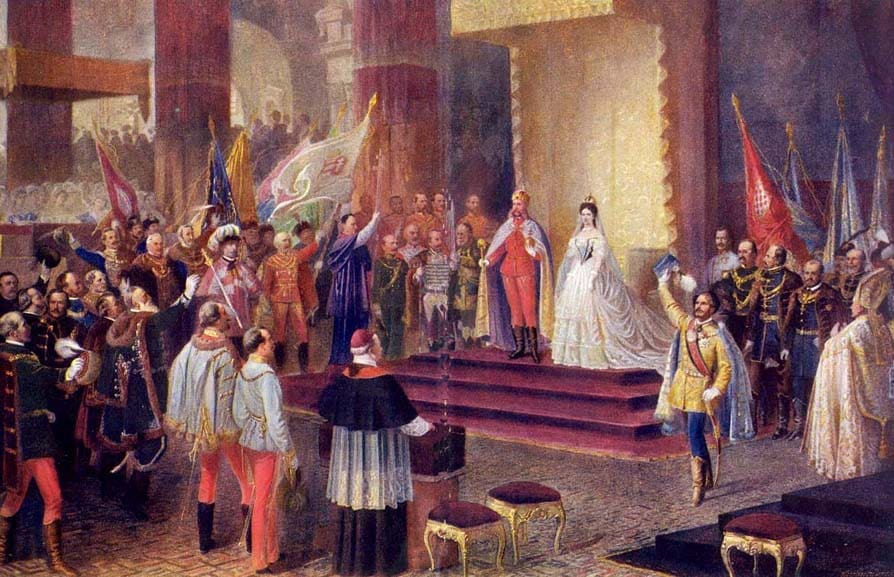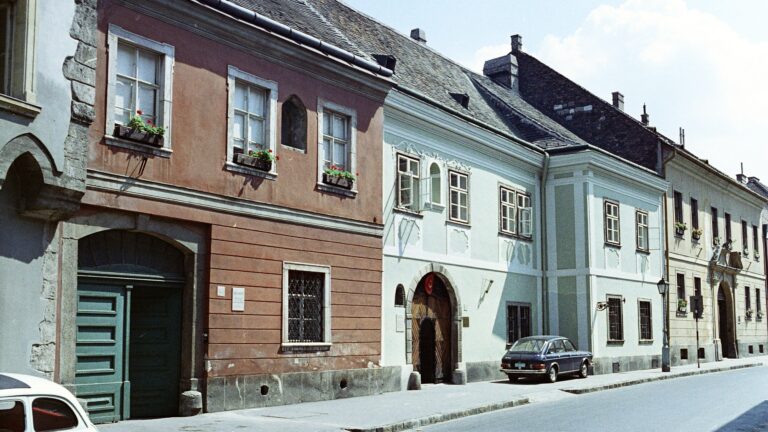The Years of the Neo-Absolutism
After the Hungarian Revolution and the War of Independence was suppressed by Austria in 1849, Hungary was placed under a neo-absolutist regime. It took various forms from the military rule of Haynau to the centralized liberal framework of the 1861 February Patent. However, at least until 1860, all regimes faced almost unified opposition from the Hungarians.
Only a few dared to try to re-launch rebellion, while others, including Kossuth, fled Hungary, and formed a government-in-exile. Those who remained, and did not take up arms, chose one of two strategies. The liberal nobility, led by Ferenc Deák, attempted passive resistance, refusing to pay taxes, assume positions in the public administration or take part in public life, and shunning Austrian officials and those Hungarians who cooperated with them. By contrast, the conservative aristocracy wrote proposals and petitions to the Habsburgs, demanding the restoration of the pre-1848 order. But whichever path was taken, it was clear that the Hungarians and their elites would never accept the centralised, neo-absolutist Habsburg Empire in its post-1849 form.
Similarly to the absolutist experience under Joseph II, this situation united the kuruc and labanc nobles.
The centralisation violated the traditional, corporative constitution of Hungary, and therefore even the few conservative aristocrats who had sided with the Habsburgs during the war turned their back on the government.
Although there were collaborators at the lower levels of public administration, the majority harboured anti-Habsburg sentiments and sabotaged tax-paying, went on strikes, ostracised those who collaborated, and wore the symbols of national independence as acts of patriotic resistance. The kuruc ethos became wildly popular during these decades, and it remained such in the long run, too, especially among Protestant Hungarians. From that time on, this sentiment was often called ‘49ist’ (referring to the date of the Declaration of Independence).
The Years of Transition and the Political Parties Elected in Hungary
After Austria was defeated by France in the Battle of Solferino, and the Habsburgs lost most of their Italian possessions, the Court was forced to attempt to make a compromise with the Hungarians. Initially, in 1860, the empire was restructured according to the views of the conservative aristocracy, and then in line with the ideas of the liberal centralists in 1861. The Hungarian elites reacted in divergent ways. Kossuth and his supporters saw the Habsburg Empire as a declining entity, and sought to create a new, confederate state of the peoples living in the Carpathian Basin. To that end, Kossuth conspired with both Napoleon III and later the Prussians, wishing to secure an intervention in Hungary. On the other hand, the moderates, led by Ferenc Deák, considered the Habsburg realm still viable, and sought to strike a deal with it, in order to restore the autonomy of Hungary inside the empire. However, the immediate restoration of the 1848 April Laws were set as a precondition of negotiations. Only the conservative aristocracy cooperated with the Court, but even they found the reforms meagre, wishing to restore the pre-1848 constitution of Hungary. The 1860 October Diploma was in fact partly their piece of work. The Diploma was, however, swiftly replaced by the centralising February Patent in 1861.
Since neither the elites, nor the masses—who engaged in often violent demonstrations—were happy with the new situation,
Emperor Francis Joseph was forced to convoke the National Assembly of Hungary.
In accordance with the 1848 suffrage, parliament had two main parties. The majority Address Party, led by Ferenc Deák, recognised the Habsburg rule, and asked for the restoration of the April Laws and the 1848 legal and political situation, issuing a formal address to the King. The Resolution Party, led by László Teleki, regarded the King as illegitimate, and therefore wanted to issue a resolution in which the restoration of the constitution would have simply been declared. These radicals sided with Kossuth and saw the full independence as their goal. While the Address Party cannot be described as labanc, the Resolutionists can definitely be classified as a kuruc and 49ist party. While Teleki won the election, most of his deputies eventually decided to vote with Deák, seeing the address as the only realistic option. However, the address was declined by the emperor, who dissolved the Diet, and placed Hungary under a ‘provisional’ dictatorship. The situation changed once again when the Habsburgs lost the Battle of Königgrätz against the Prussians, forcing them to cede the leadership over the unifying of Germany to Prussia, and also loosing Venice. The Court had no choice but to reinforce its domestic stability following the weakening of its international position.
The Compromise of 1867
During the 1860s, the Hungarian conservatives drafted a memorandum that called for the restoration of the constitution, and sought to settle the issue of foreign and military affairs by creating the so-called ‘common affairs’ of Austria and Hungary. These were to be directed by delegations, elected by the deputies of the two respective countries’ parliaments. Ferenc Deák advocated for these ideas, which were were compiled from earlier liberal and conservative pamphlets. Deák, with the mediation of the conservatives, started talks with the imperial Court.
Finally, the Law of Compromise was born in 1867,
which created the legal framework of Austria–Hungary. In theory, the new monarchy was made up of two independent nations, only united by common military and foreign affairs. Decisions in these matters were reserved for the King; however, the budget was decided on by a joint committee. All other issues were decided independently by the two parts of the realm. The National Assembly of Hungary, elected via census suffrage, made laws, albeit these could be vetoed by the Habsburg ruler, who also had a limited right to issue royal decrees.
The compromise therefore created Austria–Hungary, a stable empire, which lasted for more than 50 years, until it collapsed at the end of the First World War. While most Hungarians accepted this framework, many remained resentful, still seeing the Habsburgs as the suppressors of the 1848 Revolution. The 49ist-kuruc feeling endured, and Kossuth remained more popular than the King, Francis Joseph, although, anecdotally, it was not rare for people to have the pictures of both hanging on the wall in their living rooms.
The enduring resentment stirred symbolical ‘battles’; for instance, when the National Assembly voted to send a coronation present to Francis Joseph, the 49ers argued that the veterans of the revolutionary war should also receive a present. But the fault lines also manifested themselves in meaningful political debates. The main wedge issue was how politicians related to the Compromise. The supporters of the Compromise established the Deák Party, later called the Liberal Party. Their main goal was to preserve the legal and political status quo. The opposition to the Compromise ran under various names, such as the Party of 1848 or the Independence Party. Its adherents sought either full independence or a strict interpretation of the personal union,
building massively on Kossuth–nostalgia and kuruc feelings.
When independence was finally achieved in 1918, this party gave the first President to Hungary in the person of Mihály Károlyi. However, the Social Democrats and then the Communists promptly took over, effectively ending the political role of both the kuruc and the labanc factions.
The Kuruc and the Labanc Legacies and the Lessons for Today
Due to its lack of legitimacy, the Communist regime in Hungary tried to appropriate the kuruc legacy. The statues of anti-Habsburg revolutionaries and heroes replaced those of more traditional historical figures in the streets of Budapest: for instance, the Habsburg kings were removed from the Millennium Memorial. The Communists posed as the ultimate warriors in the ‘struggle against the 400 years of oppression’, as expressed by Marxist historian Aladár Mód. Both in Communist-controlled historiography and popular culture, the kuruc were portrayed as the heroes, while the labanc were set as insidious traitors and foreign agents. This could build upon the mainly Protestant and kuruc historiography of the 19th century, on the work of such historians as Kálmán Thaly. It is this misconstruing that has resulted in the meaning of the two terms being still distorted in the public consciousness of Hungarians today.
As mentioned in the first part of this series, the kuruc–labanc dichotomy is also often applied to today’s European politics in Hungary.
Eurosceptics often position themselves as kuruc, and their opponents as the labanc.
And indeed, this juxtaposition has a kernel of truth. The Hungarian government and its supporters (as well as the far-right on a more extreme level) tend to deliberately oppose ‘Brussels’, and stage it as an oppressive structure. On the other hand, progressives and liberals tend to accept any initiative coming from EU institutions, portraying them as beacons in the dark.
Although the kuruc–labanc dichotomy may seem as ancient history for many, we still have a lot to learn from it. If Europe, and Hungary in it, want to avoid being vulnerable to Chinese, Russian, and American interference, the European Union must become more united, at least in the areas of foreign policy and defence. The historic and modern kuruc illusions of a Hungary navigating alone between often hostile great powers is naïve, as it was demonstrated by the ill-fated kuruc dealings with the Ottomans. Criticism of the EU should therefore always be constructive and focused, as opposed to performative. On the other hand, the modern federalists are probably not only wrong, but also unrealistic when they propose bypassing nation states in the European decision-making process. What is needed is a pragmatic and nuanced foreign policy. Being part of the European integration is a core interest of Hungary, however, as a small nation, Hungary must also be careful not to lose its sovereignty to a centralised Brussels superstructure.
The kuruc were never mindless rabble-rousers, just like the labanc were never simply unpatriotic traitors. While the merits and good practices of kuruc and 49ist politicians have been been amply publicised and celebrated, the labanc side was often sidelined, and as a result, their perspectives and values are still missing from contemporary politics. It would be worth devoting more attention to the ideas of the Young Conservatives from the Era of Reform. They understood that while our interests must be unwaveringly represented and fought for, Hungary cannot stand alone in turbulent times. As István Bibó put it, we must avoid being ‘fake realists’ as much as ‘overstrained essence-visionaries’. Safeguarding our national interest and sovereignty and sticking to our European and Euro-Atlantic commitment are not mutually exclusive. In fact, with a smart political approach, they can mutually strengthen each other. Responsible politicians of the brightest days of our history, like Széchenyi and Dessewffy, have much to teach us in this regard.
Related articles:







